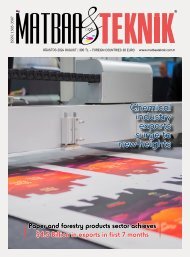Create successful ePaper yourself
Turn your PDF publications into a flip-book with our unique Google optimized e-Paper software.
8<br />
Türk tekstilin 100 yıllık yürüyüşü...<br />
Tekstil sektörü ülkemizin en eski sanayi dalıdır. Anadolu topraklarındaki tekstil tarihi<br />
Hitit ve Asur dönemlerine kadar uzanmış ve bu günlere gelişerek gelmiştir. Osmanlı<br />
İmparatorluğu’na dayanan, tekstil üretiminde uzun bir geçmişe sahip olan<br />
Türkiye, küresel tekstil ve hazır giyim sektöründe önemli bir ülke olmaya devam etmektedir.<br />
Bu yıl 100’üncü yılını kutlayan Türkiye Cumhuriyeti’nde ilk yıllardan beri<br />
birçok köklü devrim gerçekleşti. Cumhuriyet, Türkiye’nin günümüzde hazır giyim<br />
ve tekstil alanında öne çıkan ülkeler arasında yer almasını sağladı. 1920’lerden<br />
günümüze kadar yaşanan süreçte, Türk giyim tarzı ve estetiğinde büyük değişimler<br />
yaşadı. Geleneksel Türk motifleri, dokuma teknikleri küresel moda sahnesiyle<br />
bütünleşerek dünya çapında çağdaş tasarımlara dönüştü.<br />
Cumhuriyet sonrasında, devlet eliyle kurulan fabrikaların sayısı artmaya başlamıştır.<br />
Sümerbank’ın kuruluşuyla birlikte tekstil sektörünün bir sanayi olarak gelişimi sağlanmış.<br />
1930’lara gelirken, ekonomideki toplam üretim tesisleri arasında tekstil yüzde<br />
23’lük bir paya ulaşmıştır. Sümerbank 1950’li yıllara kadar, tekstilde hem üretim kapasitesi,<br />
hem istihdam gücü ve üretim değeri bakımından en önemli güç olmuştur.<br />
Ali ERDEM<br />
Yazı İşleri Müdürü<br />
News Editor<br />
Türk modasının gelişimi<br />
Değişimi temsil eden moda kavramı, sanattan yaşama, gelenek ve göreneklerden<br />
duygulara kadar birçok toplumsal olaydan etkilenerek gelişiyor. Dolayısıyla Cumhuriyet<br />
gibi büyük ve köklü bir değişimin de modayı etkilemesi mümkün değil. Türkiye’de<br />
100 yılda değişen moda, geleneksel ve modern unsurların etkileşimiyle şekillenen bir<br />
evrim sürecini yansıtmaktadır. Geleneksel Türk motiflerinin ve el sanatlarının modern<br />
tasarımlarla birleşmesi, Türk modasının zenginliğini artırmış ve uluslararası alanda<br />
tanınmasına katkı sağlamıştır. Yüzyıl içindeki bu dönüşüm, Türk modasının özgün kimliğini<br />
korurken küresel trendlere uyum sağladığını ve çeşitlendiğini göstermektedir.<br />
EDİTÖR<br />
Günümüzde Türk modası artık sadece Türkiye sınırlarında değil, uluslararası alanda<br />
da büyük bir etkiye sahip. Türkiye, bugün hem Avrupa’nın, hem de dünyanın en<br />
önemli tekstil ve hazır giyim tedarikçilerinden biri olurken Türk tasarımcılarının başarıları<br />
da tasarım alanına damgasını vurmaya devam ediyor.<br />
100-year march of Turkish textile...<br />
The textile sector is the oldest industry of our country. The history of textiles in Anatolia<br />
dates back to the Hittite and Assyrian periods and has come by developing<br />
to this day. Turkey, which has a long history in textile production dating back to the<br />
Ottoman Empire, continues to be an important country in the global textile and<br />
ready-made clothing sector. Many radical revolutions have taken place in the Republic<br />
of Turkey, which celebrates its 100th anniversary this year, since its early years.<br />
The Republic enabled Turkey to become one of the leading countries in the field of<br />
ready-made clothing and textiles. In the period experienced from the 1920s to the<br />
present day, Turkish clothing style and aesthetics have experienced great changes.<br />
Traditional Turkish motifs and weaving techniques have integrated with the global<br />
fashion scene and transformed into contemporary designs around the world. The<br />
number of factories established by the state began to increase after the Republic.<br />
With the establishment of Sümerbank, the textile sector developed as an industry.<br />
By the 1930s, textiles reached a 23 percent share among the total production facilities<br />
in the economy. Until the 1950s, Sümerbank became the most important power<br />
in textile in terms of production capacity, employment power and production value.<br />
Development of Turkish fashion<br />
The concept of fashion, representing change, has been developing under the<br />
influence of many social events, from art to life, from traditions and customs to<br />
emotions. Thus, it is not possible for a big and radical change like the Republic<br />
not to influence fashion. The fashion in, which is changing in Turkey over 100 years,<br />
reflects an evolution process shaped by the interaction of traditional and modern<br />
elements. The combination of traditional Turkish motifs and handicrafts with<br />
modern designs has increased the richness of Turkish fashion and contributed to its<br />
international recognition. This change over the century shows that Turkish fashion<br />
has adapted and diversified to global trends while preserving its unique identity.<br />
Today, Turkish fashion has a great influence not only within the borders of Turkey<br />
but also internationally. While Turkey is today one of the most important textile and<br />
ready-made clothing suppliers in both Europe and the world, the successes of<br />
Turkish designers continue to leave their mark on the design field.<br />
KONFEKSİYON TEKNİK KASIM | NOVEMBER | <strong>2023</strong>

















